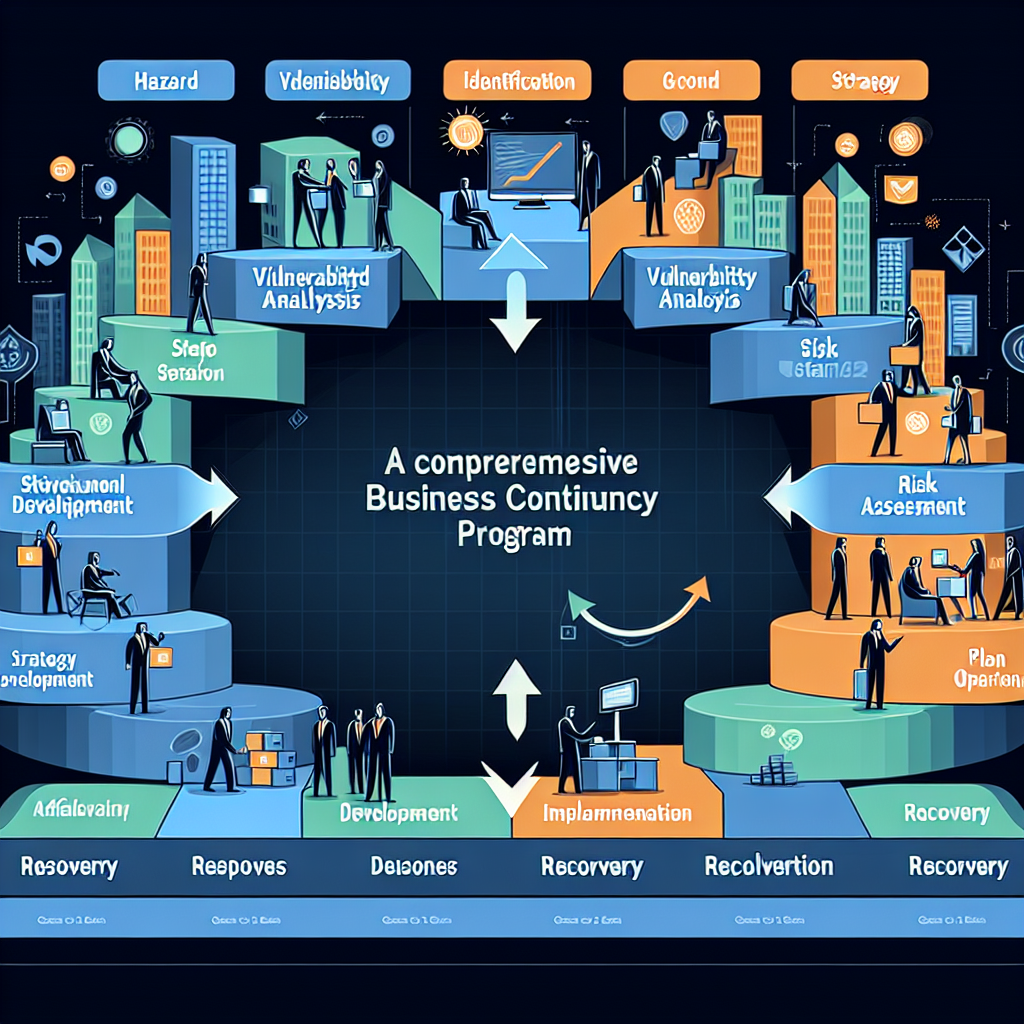Your cart is currently empty!
Tag: Risk

Ensuring Business Resilience: The Role of Business Continuity in Risk Management
In today’s fast-paced and unpredictable business environment, ensuring business resilience is more important than ever. With the increasing frequency of natural disasters, cyber attacks, and economic downturns, organizations must be prepared to handle any unexpected disruptions that may come their way. One crucial element of this preparedness is having a strong business continuity plan in place.Business continuity is the process of developing strategies and plans to ensure that a company can continue operating in the face of unexpected events. This includes identifying potential risks, assessing their potential impact on the business, and implementing measures to mitigate those risks. By having a solid business continuity plan in place, organizations can minimize downtime, reduce financial losses, and maintain the trust of their customers and stakeholders.
The role of business continuity in risk management cannot be overstated. By identifying potential risks and developing strategies to address them, organizations can better protect their assets, employees, and reputation. This proactive approach can also help businesses comply with regulatory requirements and industry standards, ultimately improving their overall resilience and sustainability.
One key aspect of business continuity planning is conducting a thorough risk assessment. This involves identifying and analyzing potential risks that could disrupt business operations, such as natural disasters, cyber attacks, supply chain disruptions, and human error. By understanding these risks, organizations can develop strategies to mitigate their impact and ensure the continuity of their operations.
Another important component of business continuity planning is developing a comprehensive response and recovery plan. This includes establishing clear roles and responsibilities, communication protocols, and backup systems to ensure that critical functions can continue in the event of a disruption. By having a well-defined plan in place, organizations can quickly respond to emergencies and minimize the impact on their business.
In addition to developing a strong business continuity plan, organizations must also regularly test and update their strategies to ensure their effectiveness. This may involve conducting tabletop exercises, simulations, and drills to identify weaknesses and areas for improvement. By continuously evaluating and refining their business continuity plans, organizations can better prepare for potential disruptions and enhance their overall resilience.
In conclusion, ensuring business resilience requires a proactive approach to risk management, with business continuity playing a crucial role in this process. By identifying potential risks, developing comprehensive response and recovery plans, and regularly testing and updating their strategies, organizations can better protect their operations and maintain business continuity in the face of unexpected events. Ultimately, investing in business continuity is an essential step towards building a resilient and sustainable business for the future.
Hannah Storm’s breast cancer diagnosis was a shock. Now the veteran sports journalist is helping others understand their risk.
As a trailblazer in the world of sports journalism, Hannah Storm has always known exactly what to say on camera. But when she received a breast cancer diagnosis in January 2024, the legendary journalist was lost for words.
“It really came as a shock,” Storm, 62, tells Yahoo Life. “It was something out of the blue.”
Storm was diagnosed with non-invasive ductal carcinoma in situ (DCIS), a breast cancer in which cells that line the milk ducts of the breast become cancerous. Even though she had no symptoms or family history of breast cancer, Storm has always mindful about her health. She had more than 20 mammograms and ultrasounds over the years, and “absolutely nothing had come up.” But this time, her physicians detected a problem.
Trusted news and daily delights, right in your inbox
See for yourself — The Yodel is the go-to source for daily news, entertainment and feel-good stories.
In the year since her diagnosis, Storm has channeled her experience into being an advocate for early detection, raising greater awareness of hereditary cancers and the crucial role of genetic testing. Here’s a look at the lessons Storm has learned on the cancer journey that transformed her life.
Preventative screenings saved her life
“Had I not been really good about my yearly screening, I never would have known it was there,” Storm says.
At the beginning of 2024, Storm had a biopsy and received her official cancer diagnosis soon after. Storm turned to her friend, tennis legend Chris Evert, who battled ovarian cancer and underwent a preventative double mastectomy due to having the BRCA1 variant. Evert connected Storm to her doctor, Dr. Elisa Port, whom she called right away.
“She said, ‘You’re not going to die from this,’” Storm recalls. “And right away, I was like, ‘Wow, thank you.’ Just hearing those words was pretty powerful.”
Always one to establish a game plan, Storm wanted to know the next best steps to take, including undergoing a lumpectomy. When her physician broached the subject of genetic testing, Storm admitted she didn’t really know what that was. But when asked about her family history, she didn’t have many answers to provide besides her father’s death from cancer. She’s not alone: A survey conducted by Myriad Genetics in 2022 found that although half of women (51%) say they have no family history of breast or ovarian cancer, many are not sure if that’s true.
Storm says she “was just so blown away by the fact that it was just a simple blood test and all the incredible amount of information that resulted from that.”
Know your risks
Early detection saved Storm’s life, and she’s hoping to empower others to practice that same diligence. Just a year after her own diagnosis, Storm has also teamed up with Myriad Genetics’s MyRisk with RiskScore hereditary cancer test to get educated on the importance of understanding your risk for hereditary cancers and how to get tested. The test evaluates 48 genes to help identify patients’ risk of developing 11 types of hereditary cancer.
While Storm understands that some people might be reluctant to learn about their risk, she views it as a way of taking control of one’s future. “I think people are like, ‘Well, I don’t want to know. It’s super scary,’” she says. “I look at it as, well, it’s super empowering.”
Those who find out that they’re at a heightened risk level shouldn’t panic, however. Instead, Storm says that’s the time to practice diligence.
“That gives you a game plan for you and your health care provider. You have the science there, you know what your risk level is,” she says. “Do you need to be hyper vigilant now? Even as a young person, do you need to undergo screening? Should you be having mammograms at a young age?”
Storm will pass what she learned on to her three daughters, who she says will be undergoing the Myriad test.
Treat your health appointments with urgency
Storm says it’s essential to stick to a rigorous preventative care schedule.
“One of the things I learned is how many people don’t prioritize themselves, especially women and their own health,” she says, noting that she treats her health appointments with the same urgency as business matters. “Moms are working, taking care of kids or taking care of their parents. We tend to take care of everybody else but put ourselves last.”
Storm says that it takes a “family effort,” and frequently tells the male athletes she works with to urge their wives and girlfriends to maintain their health appointments. “Whatever you have to do, just help her out,” she tells them. “Nobody is an island.”
A healthy diet and exercise regimen are also things that Storm focuses on. Always a fan of exercise, Storm relies on a daily weight-lifting routine, “which is really important for your bone health.” A hip replacement just a couple of months after her breast cancer surgery has required a lot of physical therapy, but Storm also enjoys cycling and walking.
Her cancer diagnosis also made her more aware of the danger of processed foods. However, she’s always been “pretty healthy. I try not to abuse my health all the time.”
Advocate for yourself
Storm’s willingness to advocate for herself throughout her cancer journey is reflective of her experience navigating the world of sports journalism, which hasn’t always been hospitable to women.
“I took a lot of abuse,” Storm says of her early days in sports. “I definitely did the best I could at the time, but the one thing that I did not let it do was defeat me. I was like, ‘You are not going to run me out of this or turn me away from following my dreams. It’s not going to happen.’ I would never give somebody like that that kind of agency and power over my life.”
Though she’s faced a lot of obstacles in her ambition to make it in sports journalism, Storm is now grateful that she was able to “knock down some doors and smash some ceilings, and just provide a sort of a reference for women in terms of what the viable career options look like in sports.”
Storm won’t be in attendance at the Super Bowl this weekend. However, she will be enjoying the big game the way she always does: hosting a Super Bowl party at her home.
“I would like to see history,” she says. “So I think would be cool to see Kansas City three-peat!”
Hannah Storm’s breast cancer diagnosis was a shock. Now the veteran sports journalist is helping others understand their risk.Hannah Storm, known for her work as a sports journalist and anchor for ESPN, was blindsided when she received a breast cancer diagnosis in 2008. The news was a shock to Storm, who had always been diligent about her health and never expected to face such a serious health issue.
But instead of letting the diagnosis defeat her, Storm decided to use her platform and experience to help educate others about breast cancer and the importance of early detection. She has been an advocate for breast cancer awareness, sharing her own story and encouraging women to be proactive about their health.
Storm’s message is clear: early detection can save lives. She knows firsthand the importance of regular screenings and being proactive about your health. By sharing her story, Storm hopes to inspire others to take charge of their own health and understand their risk for breast cancer.
In addition to raising awareness, Storm has also been involved in fundraising efforts for breast cancer research and support programs. She has used her platform to shine a light on the importance of funding research and supporting those affected by breast cancer.
Hannah Storm’s journey with breast cancer has been a challenging one, but she has emerged stronger and more determined than ever to make a difference. By sharing her story and advocating for early detection, Storm is helping others understand their risk and take control of their health. Her bravery and resilience serve as an inspiration to us all.
Tags:
Hannah Storm, breast cancer diagnosis, shock, veteran sports journalist, understanding risk, helping others, cancer awareness, women’s health, early detection, inspirational story
#Hannah #Storms #breast #cancer #diagnosis #shock #veteran #sports #journalist #helping #understand #riskFDA elevates risk, what to know
Broccoli sold at Walmart in 20 states is now the subject of a possibly deadly recall, according to the U.S. Food and Drug Administration.
Late last year, Braga Fresh, based in Soledad, California, issued a voluntary recall and product warning for Marketside Broccoli Florets, the U.S. Food and Drug Administration announced.
The FDA announced the initial recall on Dec. 31, 2024, for Braga Fresh’s washed and ready-to-eat 12-ounce bags of Marketside Broccoli Florets due to the possibility of Listeria monocytogenes contamination.
In a notice published on Jan. 27, 2025, the FDA labeled this a Class I recall − the highest recall risk level issued by the agency, as it can potentially lead to death.
Here’s what to know about the recalled broccoli including where it was sold:
Need a break? Play the USA TODAY Daily Crossword Puzzle.
Chocolate recall?Chocolate, other products recalled by company given highest risk level by FDA
What broccoli is being recalled?
Braga Fresh is recalling a single lot of 12-ounce bags of washed and ready-to-eat Marketside Broccoli Florets:
- The product has a best-used-by-date of Dec. 10, 2024.
- The UPC listed on the back of the bag is 6 81131 32884 5.
- The lot code listed on the front of the bag is BFFG327A6.
Contamination discovered during random store sampling in Texas
According to the recall notice, the broccoli may be contaminated with listeria monocytogenes.
The potential for contamination was discovered during random sampling by Texas Health and Human Services from a Texas store location where samples tested positive for listeria.
No illness have immediately been reported in connection to the recall.
If you bought the item, the FDA is advising to throw it away immediately.
What states is broccoli being recalled in?
The broccoli was sold at Walmart locations in the following states:
- Alaska
- Arkansas
- Arizona
- California
- Colorado
- Idaho
- Illinois
- Indiana
- Kentucky
- Louisiana
- Michigan
- Montana
- Nevada
- Ohio
- Oklahoma
- Oregon
- Texas
- Utah
- Washington
- Wyoming
Listeria poisoning symptoms
Listeriosis, or listeria poisoning, is a foodborne bacterial infection most commonly caused by the bacterium listeria monocytogenes, according to the Centers for Disease Control and Prevention. It is considered a serious condition and can be dangerous or life-threatening, especially to older adults, people with weak immune systems, and pregnant women.
Symptoms include, per the CDC:
- Fever
- Muscle aches
- Headache
- Stiff neck
- Confusion
- Loss of balance
- Convulsions
- Diarrhea
- Other gastrointestinal symptoms
- Miscarriage, stillbirth, premature delivery and/or life-threatening infection of newborn infants
- Death
People in higher-risk categories who experience flu-like symptoms within two months after eating contaminated food should seek medical care.
Natalie Neysa Alund is a senior reporter for USA TODAY. Reach her at nalund@usatoday.com and follow her on X @nataliealund.
The Food and Drug Administration (FDA) has recently elevated the risk level on certain medications and products. It is important to stay informed and educated on these changes to ensure your safety and well-being.Here are some key things to know about the FDA’s recent risk elevation:
1. Pay attention to any warnings or recalls issued by the FDA. If a product you are using has been deemed unsafe or high-risk, it is important to discontinue use immediately.
2. Consult with your healthcare provider if you have any concerns about the medications or products you are using. They can provide guidance on alternative options or potential risks.
3. Stay informed by regularly checking the FDA’s website or other reputable sources for updates on risk assessments and safety alerts.
4. Be cautious when trying new medications or products, and always follow the recommended dosage and usage instructions.
5. Report any adverse reactions or side effects to the FDA through their MedWatch program. Your feedback can help prevent harm to others and prompt further investigations.
By staying vigilant and proactive, you can protect yourself from potential risks associated with FDA-elevated products. Stay informed, stay safe!
Tags:
- FDA risk elevation
- FDA warning update
- FDA safety alert
- FDA risk assessment
- FDA health advisory
- FDA medication warning
- FDA public health notice
- FDA drug safety update
- FDA health risks
- FDA safety guidelines
#FDA #elevates #risk
Midweek storm to bring a risk of severe weather, significant icing to central, eastern US
Following a mostly quiet and even mild start to the week across a large part of the eastern half of the nation, a large, multifaceted storm is expected to take shape by the middle of the week that can bring a variety of impacts, say AccuWeather meteorologists.
“A clash of warm, humid air and cold Arctic air will result in a myriad of impactful weather for millions of Americans this week,” said AccuWeather Meteorologist Brandon Buckingham. “Severe thunderstorms, a dangerous ice storm and accumulating snow are all expected between Wednesday and Thursday as a storm races east.”
The storm will signal the start of what could end up being one of the stormiest periods of the winter from the Plains to the East Coast during the first half of February, perhaps partially proving Punxsutawney Phil’s prognostication of six more weeks of winter correct.
As atmospheric ingredients come together over the central states Tuesday night into the Wednesday, the storm will be underway, and first on the docket will be a risk of an icy mix on its cold side and feisty thunderstorms on its warm side, warn AccuWeather experts.
“Record-challenging warmth funneling northward into the Tennessee and Ohio River Valleys will help provide the ingredients necessary for widespread thunderstorm activity beginning Wednesday,” said Buckingham. “Some of the storms are even expected to turn severe.”
Thunderstorms are expected to blossom Wednesday afternoon around the Mississippi Valley, including the St. Louis area, before advancing toward the Ohio Valley during the evening and nighttime hours. Hail, damaging winds over 60 mph and torrential rain are the primary threats, but an isolated tornado cannot be ruled out.
Additional storms are expected farther south and east into the Tennessee Valley come Thursday, but widespread severe weather is not anticipated.
Meanwhile, on the colder side of the storm, a wintry mix of snow and ice can throw a wrench into travel plans for the middle of the week in some big cities such as Chicago, Detroit and Minneapolis. For some, the threats will go well beyond just a slippery mix.
Icicles hang from a branch of a tree in Chicago, Wednesday, Feb. 22, 2023. (AP photo/Nam Y. Huh)
“As the mild air mass clashes with frigid air farther north, the ingredients for a major ice storm are expected to be in place beginning Wednesday across a zone spanning from the Midwest to the Great Lakes,” warned Buckingham.
Significant icing, featuring a build up of 0.25 of an inch or more, can occur into Wednesday night mainly along and between the Interstates 80 and 94 corridors in Wisconsin, Illinois, Michigan, Indiana and Ohio. Hazardous travel would result from that freezing rain, which occurs when rain freezes on contact with any subfreezing surface.
AccuWeather meteorologists are warning that the impacts from icing will not just be limited to the Midwest, but will also expand into parts of the Appalachians, mid-Atlantic and Northeast later in the week.
“The potential exists for dangerous amounts of ice accretion into Thursday,” added Buckingham. “This poses a risk for tree damage and power outages as the storm moves through.”
A portion of the central Appalachians north through Pennsylvania and southern New York appear most at risk for a significant ice storm, where up to half of an inch of ice buildup is not out of the question. Cumberland, Maryland; Harrisburg, Scranton, State College and Williamsport, Pennsylvania; and Binghamton, New York, are among the cities at risk for long-lasting power outages, downed tree limbs and nearly impossible travel conditions from this storm.
Have the app? Unlock AccuWeather Alerts with Premium+
A much larger area extending as far south and east as the I-95 corridor from Washington to Baltimore, Philadelphia, New York and Boston, and north through the Toronto, Canada area, and upstate New York, are expected to see a briefer period of icing, either before a changeover to rain (in the case of the Northeast big cities) or after a period of accumulating snow (in areas farther north near the Canadian border).
Any amount of icing can lead to slippery travel, especially on untreated surfaces and bridges and overpasses. This period may end up coinciding with the Thursday morning commute in many areas, forcing delayed openings or closures for schools and businesses.
Complicating things will be the potential for cold, gusty winds to follow the storm on Thursday and Friday, potentially resulting in a rash of additional hazards even after the icing is over.
AccuWeather’s team of long-range forecasters have been hinting about a stormy first half of February since last month, and that scenario seems to be coming to fruition. In a prediction that beat Punxsutawney Phil’s by several days, wintry weather will be abundant.
“We are monitoring three potential storms between Feb. 5-11,” said AccuWeather Lead Long-Range Forecaster Paul Pastelok last month. “This will be a busy pattern with potential disruptions to travel and business.”
Following the first storm during the middle of this week, another will follow closely on its heels from Friday through next weekend. While details on where snow, ice and thunderstorms can occur are still hazy at this point, many of the same of the same areas are expected to see adverse weather and travel delays.
At least one more storm can follow for beginning early in the workweek after, and indications are that even more moisture and cold air may be available for a larger area of snow and ice then.
Want next-level safety, ad-free? Unlock advanced, hyperlocal severe weather alerts when you subscribe to Premium+ on the AccuWeather app. AccuWeather Alerts are prompted by our expert meteorologists who monitor and analyze dangerous weather risks 24/7 to keep you and your family safer.
Attention central and eastern US residents: brace yourselves for a midweek storm that is set to bring a risk of severe weather and significant icing to the region.Meteorologists are warning that a powerful storm system will sweep across the central and eastern US, bringing with it the potential for severe thunderstorms, damaging winds, and even tornadoes in some areas. In addition, parts of the region could see heavy rain and flash flooding.
But that’s not all – the storm is also expected to bring significant icing to parts of the central and eastern US, particularly in the Midwest and Northeast. This could lead to hazardous driving conditions, power outages, and potentially dangerous situations for those living in affected areas.
It’s important to stay tuned to your local weather forecast and prepare accordingly for this incoming storm. Make sure you have emergency supplies on hand, stay off the roads if possible, and listen to any warnings or advisories issued by local authorities.
Stay safe, stay informed, and stay prepared as we weather this midweek storm together.
Tags:
- Midweek storm
- Severe weather risk
- Significant icing
- Central US
- Eastern US
- Weather forecast
- Storm update
- Severe weather warning
- Icing threat
- US weather outlook
#Midweek #storm #bring #risk #severe #weather #significant #icing #central #eastern

Managing Risk and Compliance with Managed Services
In today’s fast-paced and ever-changing business environment, managing risk and compliance has become a top priority for organizations of all sizes. With the increasing complexity of regulations and the growing threat of cyber attacks, companies are finding it more challenging than ever to ensure that they are meeting all of their legal and regulatory obligations.One solution that many companies are turning to is managed services. Managed services providers offer a range of services that can help organizations effectively manage risk and compliance, while also improving overall business operations. By outsourcing these functions to a third-party provider, companies can benefit from the expertise and resources of a dedicated team of professionals who specialize in risk management and compliance.
One of the key benefits of using managed services for risk and compliance is the ability to access specialized knowledge and skills that may not be readily available within the organization. Managed services providers have a deep understanding of the regulatory landscape and can help companies navigate complex compliance requirements with ease. They can also provide valuable insights and recommendations for improving risk management processes and reducing exposure to potential threats.
In addition, managed services can help companies streamline their risk and compliance processes, saving time and resources in the long run. By outsourcing these functions to a third-party provider, organizations can free up internal resources to focus on core business activities, while also benefiting from the efficiency and expertise of a dedicated team of professionals.
Managed services providers also offer a range of technology solutions that can help companies improve their risk management and compliance efforts. From advanced data analytics tools to sophisticated cybersecurity solutions, managed services providers can help organizations stay ahead of emerging threats and ensure that they are meeting all of their regulatory obligations.
Overall, managed services can be a valuable asset for companies looking to improve their risk management and compliance efforts. By outsourcing these functions to a third-party provider, organizations can benefit from specialized expertise, streamlined processes, and advanced technology solutions that can help them effectively manage risk and compliance in today’s complex business environment.

Ensuring Business Resilience: The Role of Continuity Planning in Mitigating Risk
In today’s rapidly changing business landscape, ensuring resilience has become a top priority for organizations of all sizes. With the increasing frequency of natural disasters, cybersecurity threats, and global pandemics, the need for robust continuity planning has never been more important.Continuity planning is a proactive approach to identifying and mitigating risks that could disrupt business operations. It involves developing strategies and procedures to ensure that essential functions can continue in the event of a crisis. By implementing continuity planning, businesses can minimize the impact of disruptions and maintain operations during challenging times.
One of the key benefits of continuity planning is its ability to reduce financial losses. By identifying potential risks and developing mitigation strategies, businesses can avoid costly downtime and minimize the impact on revenue. In addition, continuity planning can also help organizations protect their reputation and maintain customer trust by demonstrating their ability to respond effectively to crises.
Another important aspect of continuity planning is its role in ensuring compliance with regulatory requirements. Many industries, such as finance, healthcare, and government, have strict regulations governing business continuity and disaster recovery. By implementing a comprehensive continuity plan, organizations can demonstrate their commitment to compliance and avoid potential penalties for non-compliance.
In addition to financial and regulatory benefits, continuity planning can also improve overall organizational resilience. By identifying vulnerabilities and developing response strategies, businesses can build a culture of preparedness and adaptability. This can help organizations respond more effectively to unexpected events and navigate through uncertainty with confidence.
There are several key steps that organizations can take to ensure effective continuity planning. First, it is important to conduct a thorough risk assessment to identify potential threats and vulnerabilities. This could include natural disasters, cyberattacks, supply chain disruptions, and other potential risks.
Once risks have been identified, organizations can develop a continuity plan that outlines specific strategies and procedures for responding to each threat. This plan should include clear roles and responsibilities, communication protocols, and recovery procedures to ensure a coordinated response in the event of a crisis.
Regular testing and training are also critical components of effective continuity planning. By conducting drills and exercises, organizations can identify gaps in their plan and refine their response strategies. Training employees on their roles and responsibilities during a crisis can also help ensure a swift and effective response.
In conclusion, continuity planning plays a crucial role in ensuring business resilience in the face of increasing risks and uncertainties. By proactively identifying and mitigating potential threats, organizations can minimize the impact of disruptions, protect their financial interests, and maintain operations during challenging times. By investing in continuity planning, businesses can build a strong foundation for resilience and adaptability in an ever-changing business environment.

Mitigating Risk: How Business Continuity Plans Can Save Your Company
In today’s unpredictable business landscape, it is essential for companies to have a solid plan in place to mitigate risks and ensure continuity in the face of unexpected events. From natural disasters to cyber-attacks, there are countless threats that can disrupt operations and potentially harm a company’s bottom line. This is where business continuity plans come into play.Business continuity plans are comprehensive strategies that outline how a company will continue to operate in the event of a disruption. These plans typically include detailed procedures for responding to emergencies, maintaining critical functions, and ensuring the safety of employees and assets. By implementing a business continuity plan, companies can minimize downtime, avoid financial losses, and protect their reputation in the marketplace.
One of the key benefits of having a business continuity plan is that it allows companies to identify and assess potential risks before they occur. By conducting a thorough risk assessment, companies can pinpoint vulnerabilities in their operations and take proactive steps to mitigate them. This can include implementing redundant systems, creating backup plans, and investing in disaster recovery solutions.
In addition to reducing the impact of disruptions, business continuity plans also help companies comply with regulatory requirements and industry standards. Many regulatory bodies require companies to have a business continuity plan in place to ensure the safety and security of their operations. By having a plan that meets these requirements, companies can avoid costly fines and legal repercussions.
Furthermore, business continuity plans can also improve the overall resilience of a company. By regularly testing and updating their plans, companies can build a culture of preparedness and adaptability within their organization. This can help employees respond more effectively to emergencies and quickly recover from disruptions, ultimately strengthening the company’s ability to weather future challenges.
In conclusion, business continuity plans are a critical tool for companies looking to mitigate risks and ensure the long-term success of their operations. By investing in a comprehensive plan that addresses potential threats and outlines clear procedures for response and recovery, companies can protect their assets, employees, and reputation in the face of unexpected events. Ultimately, having a business continuity plan in place can mean the difference between surviving a crisis and succumbing to it.

From Risk Assessment to Recovery: Steps for Implementing a Comprehensive Business Continuity Program
In today’s fast-paced business environment, disruptions can occur at any time, from natural disasters to cyber attacks. It is crucial for organizations to have a comprehensive business continuity program in place to ensure that they can continue operating and serving their customers in the face of adversity. From risk assessment to recovery, there are several steps that organizations can take to implement a robust business continuity program.The first step in implementing a business continuity program is conducting a thorough risk assessment. This involves identifying potential threats and vulnerabilities that could disrupt business operations, such as natural disasters, cyber attacks, or supply chain disruptions. By understanding the risks that the organization faces, business continuity planners can develop strategies to mitigate these risks and ensure that critical business functions can continue in the event of a disruption.
Once the risks have been identified, the next step is to create a business continuity plan. This plan should outline the steps that need to be taken to ensure that critical business functions can continue operating during a disruption. It should include detailed procedures for responding to different types of disruptions, as well as a communication plan for keeping employees, customers, and other stakeholders informed.
Training and testing are also essential components of a comprehensive business continuity program. All employees should be trained on their roles and responsibilities in the event of a disruption, and regular drills and exercises should be conducted to test the effectiveness of the business continuity plan. This will help to ensure that everyone knows what to do in an emergency and that the organization can respond quickly and effectively to any disruptions that occur.
In the event of a disruption, the final step in the business continuity process is recovery. This involves restoring critical business functions and minimizing the impact of the disruption on the organization. Recovery efforts may include restoring IT systems, relocating employees to alternative work locations, and communicating with customers and other stakeholders about the status of operations.
By following these steps and implementing a comprehensive business continuity program, organizations can better prepare for and respond to disruptions, ensuring that they can continue operating and serving their customers even in the face of adversity. With careful planning, training, and testing, organizations can minimize the impact of disruptions and recover quickly, maintaining their reputation and competitive advantage in the marketplace.

Mitigating Risk: The Importance of a Comprehensive Disaster Recovery Strategy
In today’s fast-paced business environment, companies face a myriad of risks that can threaten their operations and ultimately their bottom line. From natural disasters to cyber attacks, the potential for disruptions is ever-present. That’s why having a comprehensive disaster recovery strategy in place is crucial for mitigating risk and ensuring business continuity.A disaster recovery strategy is a plan that outlines how an organization will respond to and recover from unexpected events that could disrupt its operations. This includes natural disasters such as hurricanes, earthquakes, and floods, as well as man-made disasters like cyber attacks, data breaches, and power outages.
One of the key reasons why a comprehensive disaster recovery strategy is so important is that it helps businesses minimize downtime in the event of a disaster. By having a plan in place that outlines how to quickly restore critical systems and operations, companies can avoid prolonged disruptions that could lead to significant financial losses.
Additionally, a well-thought-out disaster recovery strategy can help businesses comply with regulatory requirements and industry standards. Many industries have strict regulations in place that require companies to have a plan for recovering from disasters and protecting sensitive data. By having a comprehensive strategy in place, organizations can demonstrate their commitment to compliance and minimize the risk of facing costly fines or penalties.
Furthermore, a disaster recovery strategy can also help businesses protect their reputation and maintain customer trust. In today’s digital age, news of a data breach or prolonged downtime can spread quickly on social media and damage a company’s reputation. By having a plan in place to quickly recover from disasters and communicate effectively with customers, businesses can minimize the impact on their brand and retain the trust of their stakeholders.
In order to create an effective disaster recovery strategy, businesses should first assess their risks and vulnerabilities. This includes identifying potential threats, evaluating the impact they could have on operations, and determining the critical systems and data that need to be protected.
Next, organizations should develop a plan that outlines how they will respond to different types of disasters, including who will be responsible for each task and how communication will be handled. This plan should also include protocols for testing and updating the strategy on a regular basis to ensure it remains effective.
Finally, businesses should consider investing in technology solutions that can help streamline the recovery process. This may include cloud backup and recovery services, data encryption tools, and cybersecurity measures to protect against cyber threats.
In conclusion, having a comprehensive disaster recovery strategy is essential for mitigating risk and ensuring business continuity. By proactively planning for unexpected events and implementing the necessary measures to quickly recover from disasters, organizations can protect their operations, comply with regulatory requirements, and maintain the trust of their stakeholders. Investing in a robust disaster recovery strategy is not only a smart business decision, but it is also a critical step in safeguarding the future of your organization.






